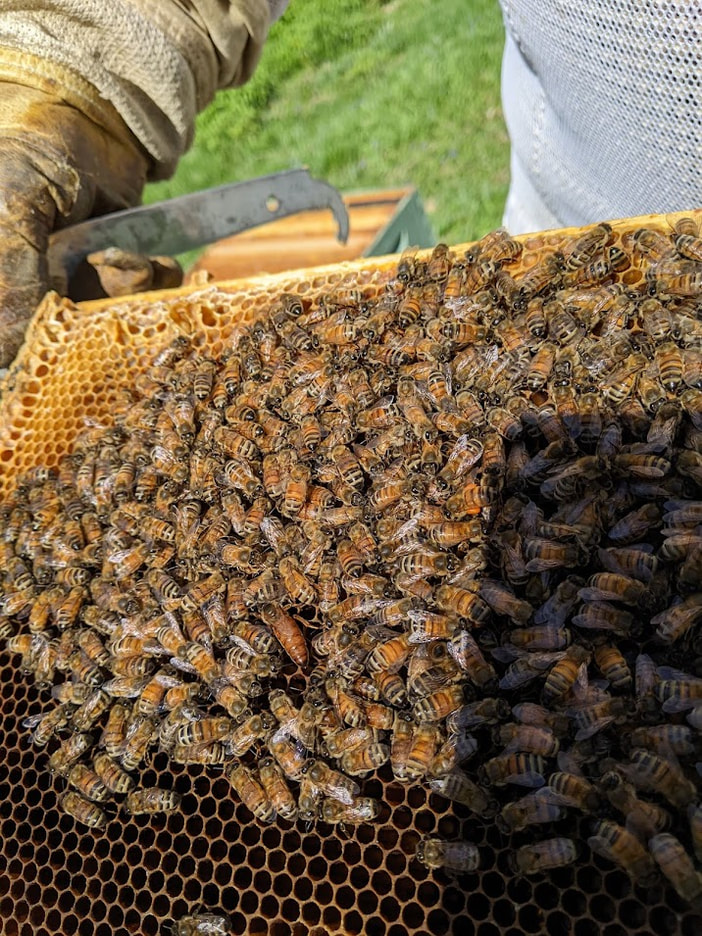 Sorry for the lame picture, but I forgot to take photos this check. I will say that this pic is for C who said he's never seen a honey bee on a dandelion. This check, we managed to inspect the hive just after a fast-moving thunderstorm, so all the bees were home to greet us, and WOW there were a lot of bees! At the last check there were maybe 4 frames of bees, but at this check we had about 14 out of 16 frames with bees on them. After removing the feeders (all 3 quarts were empty FYI) and finding the queen, we moved around some frames to give her more space to lay and then popped on the queen excluder and the Flow Hive super. BUT, we're still a little nervous about her having enough space, so the plan is to give the hive a 3rd deep for the brood chamber at the next check. We didn't end up doing the mite check, so that'll be at the next hive inspection as well. Plan for next check: 1. Add 3rd deep box of comb for a larger brood chamber. 2. Mite check +/- treatment if above threshold of 3% (3 mites/100 bees). 3. Examine Flow Hive super for nectar storage +/- moving up a honey frame to encourage bees to use it. The next Flow Hive Team check will be on Sunday, May 29th at 11am in the A2B2 Teaching Apiary at Matthaei Botanical Gardens. Hope you can bee there! If you would like to join the A2B2 Flow Hive Team or would like to know more about the Flow Hive in general, please contact Jen Haeger at [email protected].
0 Comments
 And there was much rejoicing! Today we saw the young queen that the hive made last summer. She is fat and happy and laying like gangbusters, so though there was still only about 4 frames of bees, we expect an explosion of bees at the next check. The colony had also taken down about 2 full quarts of 1:1 sugar syrup this time, so we refilled those feeders and left them with 3 full quarts. Another interesting thing we did was to move the deep box with all the bees in it above the one with just comb so that the bees are closer to the sugar syrup. Normally in the spring you would make sure that a growing hive had plenty of space above it to expand and even take empty boxes from the bottom of the hive (left empty when the bees moved upwards during the winter), and place them above the top boxes where the bee cluster moved to (called a reverse). However, when a hive has very few bees in it to keep the brood warm, you don't want those bees to have to travel through an entire empty box to get to their sugar syrup on top of the top frames. When the colony is a little more robust, we'll see if we have to move that box of empty comb back to the top to give them more space or if the queen found her way down into that empty box all on her own. No Varroa mite check today because there just weren't enough bees. The next official Flow Hive Team check will be on Saturday, May 21st at 10am in the A2B2 Teaching Apiary at Matthaei Botanical Gardens. Hope you can bee there! Plan for Next Check: 1. Make sure hive is still queenright. 2. Check for signs of crowding/swarming cues. 3. Check for signs of disease. 4. If enough bees, perform a Varroa mite check. 5. Refill syrup if still taking it, if not, remove feeders and add queen excluder and Flow Hive Honey Super. If you would like to join the A2B2 Flow Hive Team or would like to know more about the Flow Hive in general, please contact Jen Haeger at [email protected]. |
What is a Flow Hive?
A Flow Hive is a Langstroth-style hive system with plastic frames which allow honey to be harvested directly from the hive. www.honeyflow.com/pages/how-flow-works Archives
May 2024
Categories |

 RSS Feed
RSS Feed
